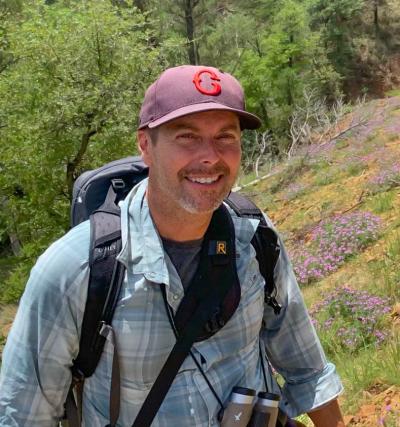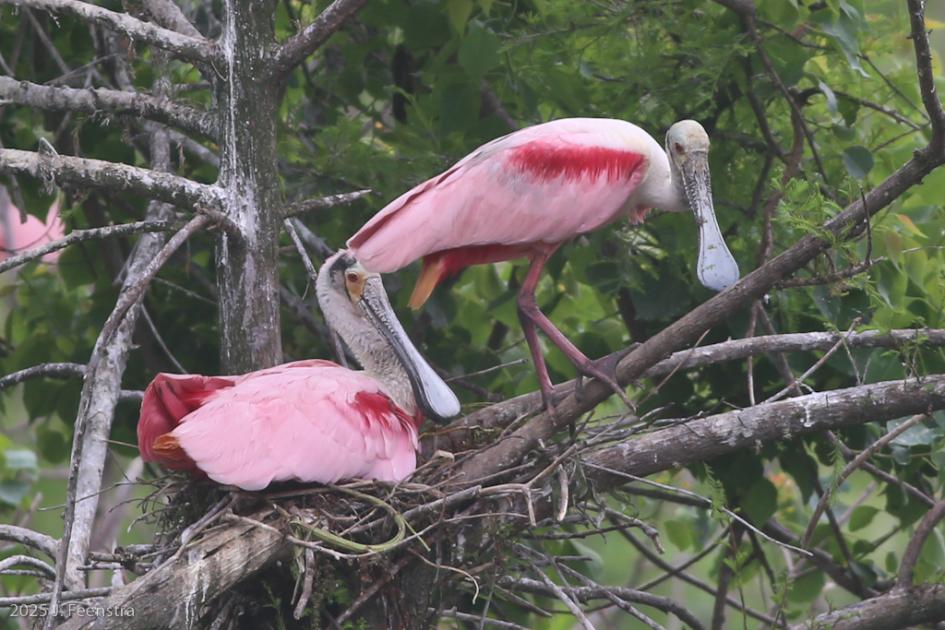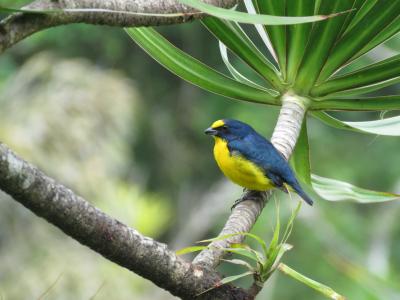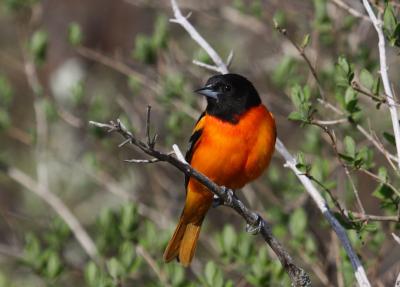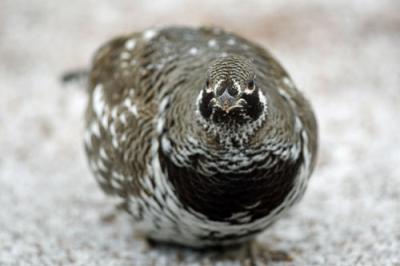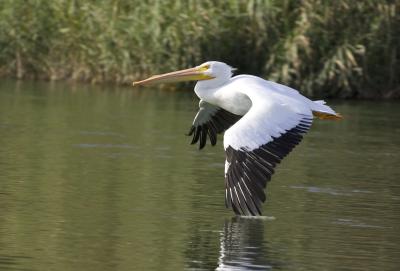Texas: The Upper Coast
-
Apr 16-23, 2026
Ben Lucking
2026
Single Occupancy Supplement $580
2026
Single Occupancy Supplement $580
There may be no better birdwatching in North America than what one may encounter on the northwestern shores of the Gulf of Mexico in spring.
Between mid-March and mid-May, masses of passerines wing north from their wintering grounds and a significant percentage of them pass through this corridor. Add to this both migrant and resident waterbirds including large numbers of herons and spoonbills, shorebirds of 30 or more species, and a profusion of gulls and terns, and it’s no wonder this area is as famous as it is.
Less predictable is what the weather can do to this migration pipeline. If the weather is fair or the winds blow from the south, the countless thousands of migrant thrushes, vireos, warblers and buntings that reach the coast after completing their lengthy trans-Gulf of Mexico migration move along and disperse among the more suitable forests in the interior. But, if they encounter rain or strong north winds before or as they reach the coast, large numbers may drop into the first isolated clumps of vegetation. Called a “fall out,” this phenomenon constitutes one of the great visible migration spectacles in North America and if it occurs during our stay, we’ll alter plans if necessary to bear witness.
Though the migrants alone would draw birdwatchers to this area, the area is rich in resident bird life, as well: nearby pine woods and cypress swamps are home to some of North America’s most sought-after breeding birds. Texas in April is simply full of birds.
Day 1: The tour begins this evening with a 6 pm meeting at our hotel near George Bush Intercontinental Airport, Houston. Night in Houston.
Day 2 – Leaving Houston, we’ll stop in a small woodlot that has a few breeding pairs of Red-cockaded Woodpeckers and their fellow North American endemic Brown-headed Nuthatch. We’ll continue toward Jasper, Texas, and the Angelina National Forest for a night stopping along the way at some parks for breeding birds that we may not find on the coast such as Red-headed Woodpecker, Yellow-throated and White-eyed Vireos, Northern Parula, and Yellow-throated, Prothonotary, Swainson’s, Worm-eating and Kentucky Warblers among others. Once in the Jasper area, we may stop at Boykin Springs for Louisiana Waterthrush and along the forest edge for breeding Prairie Warblers (a local breeder in east Texas). While at the parks and along the drive we’ll watch the skies for Red-shouldered and Broad-winged Hawks and Mississippi Kites. We sometimes see a Swallow-tailed Kite, too. Night in Jasper.
Days 3-6: After searching for Bachman’s Sparrows in Angelina National Forest early this morning when their lovely song makes them easier to find, and perhaps do a bit more searching for warblers, we’ll leave the Jasper area for Winnie, our base for explorations of the Upper Texas and Louisiana coasts. These days will be varied and, we hope, spectacular. The central focus will be Sabine Woods and High Island, celebrated land bird migrant traps but ones that require special weather to produce a major fall-out of birds. If we’re lucky, cuckoos, thrushes, vireos, warblers of 25 or more species, tanagers, buntings, and orioles will fill these small woods and provide a memorable birdwatching experience.
As High Island and Sabine Woods tend to have more migrants in the afternoon, we’ll spend several mornings looking at water birds. The heronry at nearby Smith Oaks offers intimate looks at nesting Roseate Spoonbill, Snowy and Great Egrets; mudflats and beaches can hold thousands of herons, gulls, terns, and shorebirds of up to 20 species, including Piping and Wilson’s Plovers, often American Oystercatcher, and sometimes thousands of brilliant American Avocets. Flooded rice fields near Winnie can host large numbers of shorebirds, including American Golden-Plover and Pectoral Sandpiper, often joined by Buff-breasted Sandpipers and sometimes White-rumped Sandpiper and Hudsonian Godwit. The wonderful marshes at Anahuac National Wildlife Refuge are recovering from the hurricanes in 2017, and are home to both Fulvous and Black-bellied Whistling-Ducks, Least Bittern, White-faced Ibis, Clapper and King Rails, and Purple Gallinule. There are a few small woodland patches around the marsh that can be good for migrant landbirds.
On one day we’ll visit Cameron Parish in southwestern Louisiana to Johnson’s Bayou and a normally uncrowded Baton Rouge Audubon Society woodlot that captures migrants in the same way as High Island and Sabine Woods. On another day we will drive the coast of the Bolivar Peninsula, stopping in marshes and at beaches to sift through gulls, terns, and shorebirds, as well as look for coastal specialties like Nelson’s and Seaside Sparrows and scan the skies for hunting White-tailed Kites. Nights in Winnie.
Day 7: After a final full day in the field on the Upper Texas Coast, we’ll return to Houston, perhaps via the Trinity River bottoms, where we sometimes find a Swallow-tailed Kite or target any reported rarities in the parks of suburban Houston. Night in Houston.
Day 8: The tour concludes this morning in Houston.
Note: The information presented below has been extracted from our formal General Information for this tour. It covers topics we feel potential registrants may wish to consider before booking space. The complete General Information for this tour will be sent to all tour registrants and of course supplemental information, if needed, is available from the WINGS office.
ENTERING THE UNITED STATES: Non-U.S. citizens will need a valid passport and may need a tourist visa. Consult your nearest U.S. Embassy or consulate for details.
PACE OF THE TOUR: Days will be full, with departures usually around 5:30 to 6 AM and returning to the hotel usually by 8:00 p.m. after a group dinner. Although we spend much time on foot, our walks are at a leisurely pace and on flat terrain, so not at all strenuous. The one possible exception is the walk for Yellow Rails conducted by staff or associates of Anahuac National Wildlife Refuge. This walk is strenuous, walking through up to knee-high grass over irregilar and sometimes wet terrain. Some choose to watch from the sidelines and often get identifiable views of Yellow Rail in flight. However, this walk has been discontinued as of 2017. The WINGS office will pass along news if the walk has been revived.
HEALTH: East Texas presents no real hazards to the visiting birdwatcher.
Insects: East Texas has mosquitoes, ticks, and chiggers, though the latter two are infrequently encountered. We recommend using insect repellents with a high concentration of DEET.
Fire ants are widely distributed and noxious. The leaders will identify the ants at first encounter and remind you frequently to watch where you stand.
Zika: This virus is expanding northward from tropical South America into the northern Caribbean and southern United States and health authorities are still trying to gage its full impact. Couples who expect/hope to become pregnant should consult their physician. The virus is transmitted by mosquitos of the genus Aedes, a day-flying mosquito typically found near people in crowded urban environments that have only a minimum of public services like sanitation, window screens, and drainage; in other words locations that aren’t on most tour itineraries.
Smoking: Smoking is prohibited in the vehicles or when the group is gathered for meals, checklists, etc. While in the field or traveling, use of a smokeless alternative such as nicotine gum is requested. Please do not smoke at short stops while traveling. If you smoke in the field, do so well away and downwind from the group and leave ample time between smoking and getting back into the vehicle. If you are sharing a room with a non-smoker, please do not smoke in the room. If any lodge, accommodation or location where the group is staying or is gathered has a more restrictive smoking policy than WINGS’ policy, the more restrictive policy will prevail. The leader reserves the right to modify this policy if the situation warrants it.
Miscellaneous: In April the sun can be intense. A broad-brimmed hat, proper clothing and strong sun screen lotion are essential.
As it may be difficult to replenish supplies of personal medications, please anticipate your needs and bring an adequate supply.
CLIMATE: April is variable in East Texas. It is often humid and temperatures may rise into the high 80s (F) or drop into the high 40s (F) after passage of a cold front. Rain occurs periodically with the passage of fronts but in some years it remains dry.
ACCOMMODATIONS: We stay in standard, comfortable hotels. Wireless Internet is available throughout.
FOOD: Food on the tour is U.S. standard with some good seafood options. Most lunches will be picnics. WINGS tours are all-inclusive and no refunds are available for missed meals.
Food Allergies / Requirements: We cannot guarantee that all food allergies can be accommodated at every destination. Participants with significant food allergies or special dietary requirements should bring appropriate foods with them for those times when their needs cannot be met. Announced meal times are always approximate depending on how the day unfolds. Participants who need to eat according to a fixed schedule should bring supplemental food. Please contact the WINGS office if you have any questions.
TRANSPORTATION: We will be traveling by 15- (or 12) passenger window van or minivan, depending on the group size. When using 15-passenger window vans, we take a maximum of seven passengers plus the leader. Participants should be able to ride in any seat in tour vehicles.
2025 Narrative
The upper Texas coast is a place of dynamic change. Its expansive wetlands and the scattered woodlands like High Island are places where anything can happen at any time. Droves of shorebirds and landbirds pass through this area on their flights north up the central flyway. To the north of High Island, this region is backstopped by the woodlands of the Big Thicket and the upland pineywoods, where some of these birds stay to breed, joining specialized resident species tied to this habitat. Our week in the area was a bit of all of this, and our highlights reflected that. We had scope views of Swainson’s Warbler, Prairie Warbler, and Bachman’s Sparrow on their breeding territories. We also had a few Swallow-tailed Kites circling just over the road on some regular driving. On the coast, we were treated to great looks at some fantastic warblers, including a Cape May and a Louisiana Waterthrush, plus both Black-billed and Yellow-billed Cuckoos, plenty of Scarlet Tanagers, and Indigo and Painted Buntings. Other greats on the coast were both Least and American Bitterns skulking (not very well) in the reeds and the epic breeding colony of waders, including Tricolored Herons and dazzling Roseate Spoonbills. There was so much to see and every day was a little (or a lot) different.
Our first morning, leaving Houston, we didn’t need to go far before birding happened. A woodlot north of the city was our first stop, and though it took a little wandering around, we ended up with great looks at Red-cockaded Woodpeckers, flying around, flaking bark, and even at a nest hole. Also around were a few of the well-named and striking Red-headed Woodpeckers. We saw some Pine Warblers, as well, but, for this trip, the warblers were just getting started. From there, we drove northwest through the Big Thicket, stopping for a picnic lunch and more birding. The temperature was getting up there, but the birds were singing, and it didn’t take long for us to find a glowing Prothonotary Warbler, a dapper Yellow-throated Warbler, proper looks at Pine Warbler, and we simply enjoyed these birds as they sang from their breeding territories.
The next morning started warm and pleasant, and we had the privilege of watching a Bachman’s Sparrow sing its sweet song in the pine savannah. From there, we began our journey south toward the coast, but not before pulling off the road to see three Swallow-tailed Kites winging around over the treetops, picking off dragonflies and eating them on the wing. Another stop in the Big Thicket got us looks at a singing Swainson’s Warbler. Once nearer the coast, we drove the roads through the vast agricultural fields looking for shorebirds. We found a few nice flocks out there including one of about 50 Buff-breasted Sandpipers. Another flock had hundreds of shorebirds of fifteen species, including White-rumped Sandpipers, Ruddy Turnstones, Pectoral Sandpipers, and Stilt Sandpipers. Though, not shorebirds, we also saw a few Swainson’s Hawks circling about and checked out a nest of Barn Owls in a building in the Anahuac/Nungaray National Wildlife Refuge.
South winds were blowing when we woke up, which usually isn’t a good sign for there being passerines in the coastal woods, but we decided to give Louisiana a try and went for their coastal woodlands. It being Easter Sunday, we also figured that might get us out of the crowds of Texas birders in the Texas woods. It was a good move. There weren’t tons of birds, but there was quality, and we saw a Cape May Warbler, a species that winters in the Caribbean and normally skips this area. We also saw a couple of Blackpoll Warblers, a few Painted Buntings, and lots of Orchard Orioles and Indigo Buntings. As it got warmer midday many birds were coming to the misting drip birdbath that added an extra layer of cooperation. A bathing Swainson’s Thrush was a particular favorite and it spent a long time being watched by us. After lunch, we returned to Texas and the coastal woodlands. There must have been some afternoon arrivals of birds crossing the Gulf because the woods were busy. There were both Black-billed and Yellow-billed Cuckoos, both Northern and Louisiana Waterthrushes, plus other new goodies like Blue-winged Warbler and lots of Hooded Warblers.
We visited the coast at the Bolivar Flats shorebird sanctuary the next morning. There was a troubled sky to the northwest with rain threatening, but we started in the saltmarsh and got to watch a fluffy black Clapper Rail chick following its parent around the edge of the marsh. Then we walked out along the beach to the end of the flats to see thousands of shorebirds, terns, and various other waterbirds feeding and resting on the sand. Black Terns were flying around picking at the white caps and Black Skimmers were winging by pushing their bills through the water. With howling wind and an approaching thunderstorm, we returned to the van, and drove down the road into one of the grassy marshes where we had accommodating, singing, and charismatic denizens Sedge Wren and Seaside Sparrow. Then the rain stopped threatening and unloaded on us just as we were leaving to take shelter for lunch. The storm blew through, and we drove to High Island in hopes that it dropped some birds migrating across the Gulf. Sadly, there were only a few things, but fortunately, we were also near an amazing heron rookery, so we finished the day seeing hundreds of Snowy Egrets, Great Egrets, Tricolored Herons, Roseate Spoonbills, and Neotropic Cormorants jumping around, making weird noises, and doing nesting stuff. Many nests had young and we very much enjoyed watching adults and nestlings messing around together.
We began the day back out on the Bolivar Peninsula to mop up a few misses out there. We saw more shorebirds, plus a lone American White Pelican and an American Oystercatcher. A front yard full of Black-bellied Whistling-Ducks was pretty fun, as well. We then returned to the Anahuac/Nungaray NWR to drive the loop through the marsh. We saw a few more Black-bellied Whistling-Ducks, plus a lot of Fulvous Whistling-Ducks, some Least Bitterns, a Sora, many White Ibis, and lots of American Alligators. Right at the entrance office we also found an American Bittern skulking on the side of the pond catching crayfish and the nest of three fuzzy Barn Owlets. After all that and lunch, we returned to driving around agricultural land looking for whatever might be out in the flooded rice fields. We came across a confusing juvenile Swainson’s Hawk on the ground in a field, plus some stunning Scissor-tailed Flycatchers, and a King Rail moving sneakily along the edge of a roadside ditch. We finished the day at Boy Scout Woods on High Island with a few glowing Scarlet Tanagers and a couple of sleeping Common Nighthawks.
With more rain threatening, we began our last day on High Island at the heron, spoonbill, and cormorant rookery. The cacophony of nesting birds continued, and we enjoyed more looks at Roseate Spoonbills tending to the tiniest of young, Tricolored herons rearranging eggs, and, today, some Little Blue Herons sitting tight. Migrant birds were pretty sparse, but we had close looks at a very cooperative Black-throated Green Warbler foraging at eye-level. But, it became time to move along and back out to Houston. And the rain started. Our first stop was conveniently an underpass of I-10, so, though noisy and weird, it was a great place to stay dry and watch Cliff and Cave Swallows winging around. The Cliff Swallows nested on the outside (the cliff) while the Cave Swallows nested on the inside (the cave). With continuing rain we made a few more brief stops, but one, in particular, was fun and got us a family group of Egyptian Geese, a Least Grebe, and completely soaked. Oh, the memories. No problem, though, the weather was warm, it was great fun, we were on our way to the hotel, and it gave us even more to talk about over our final dinner.
Maximum group size seven with one leader.




























